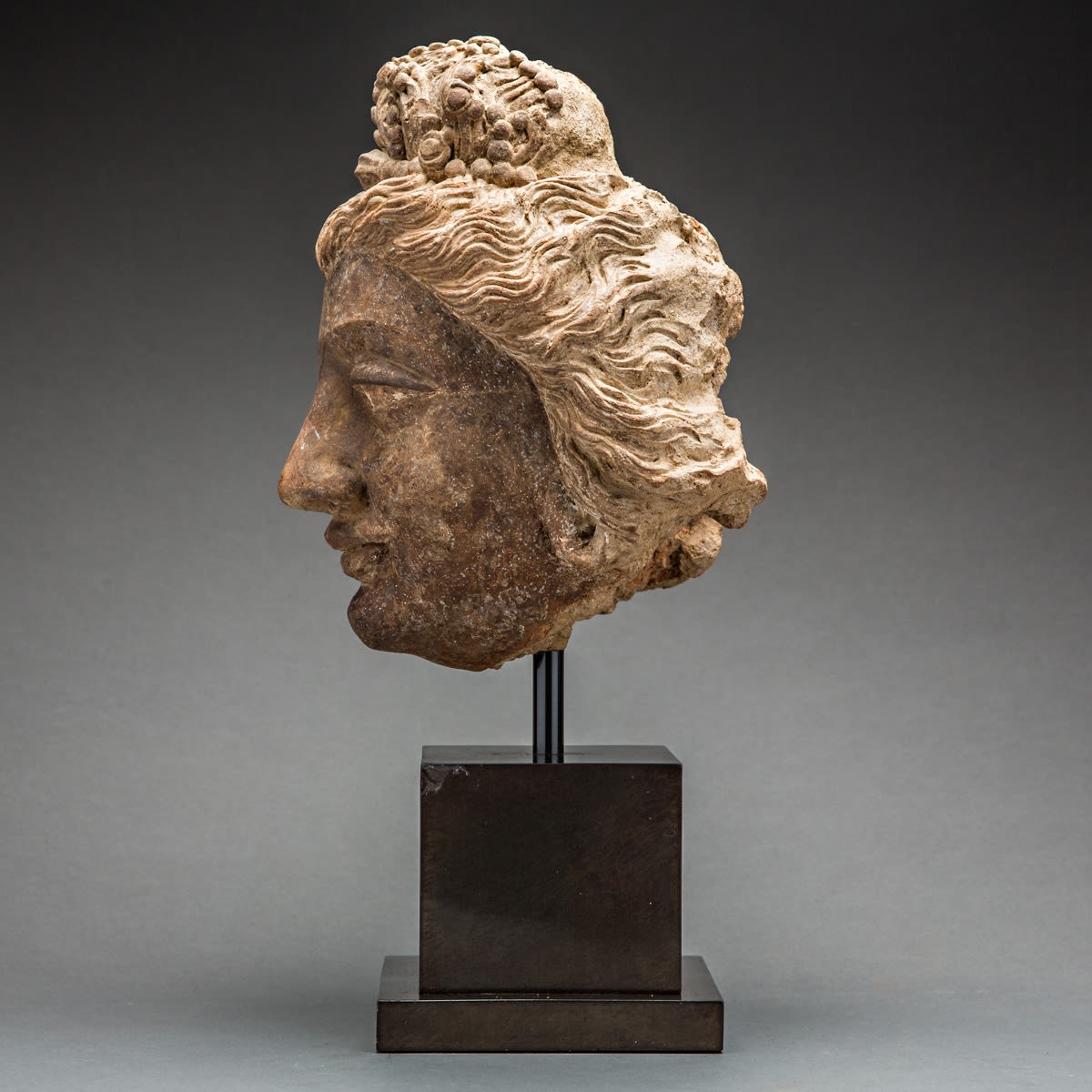Gandhara Stucco Head of a Bodhisattva, 100 CE - 300 CE
Stucco
height 26 cm
height 10 1/4 in
height 10 1/4 in
LO.606
Further images
The ancient civilization of Gandhara was located in the region encompassing modern northeaster Afghanistan and northwestern Pakistan. Situated at confluence of trading paths along the Silk Route, th area was...
The ancient civilization of Gandhara was located in the region encompassing modern northeaster Afghanistan and northwestern Pakistan. Situated at confluence of trading paths along the Silk Route, th area was flooded in diverse cultural influence ranging from Greece to China. Gandhara flourished under the Kushan Dynasty and their great king, Kanishka, who is traditionally given credit for spreading the philosophies of Buddhism throughout central Asia and into China. This period is viewed a the most important era in the history of Buddhism.
After the conquests of Alexander the Great, the creation of Greco-Bactrian kingdoms, and the general Hellenization of the subcontinent, Western aesthetic became prominent. Greek influence began permeating into Gandhara. Soon sculptors based the images of the Buddha on Greco-Roman models, depicting Him as a stocky and youthful Apollo, complete with stretched earlobes and loose monastic robes similar to a Roma toga. The extraordinary artistic creations of Gandhara reveal links between the different worlds of the East and West. In the Buddhist religion, Bodhisattvas are souls who have attained enlightenment and no longer need to reincarnate, but forsake nirvana and choose to come back in order to alleviate the suffering of others. This stunning Gandharan stucco sculpture of the head of a Bodhisattva reveals that these spiritual beings were celebrated even then, as Buddhism began to spread from India eastwards.
This head was likely once attached to a body, the whole of which probably stood in a niche on the exterior of a stupa or shrine. These Bodhisattva sculptures are also thought to be depictions of Kushan kings and princes. Their luxurious adornments, see here in the beaded hair ornament that covers his top knot, suggests their wealth. The thin moustache is also typical of such representations. The artists of Gandhara were the first to represent the Buddha in his human form, an opposed to a symbol such as his footprint. This gorgeous head is a reminder of an ancient civilisation that, although vanished, helped spread the teaching of enlightenment throughout the heart of Asia.
After the conquests of Alexander the Great, the creation of Greco-Bactrian kingdoms, and the general Hellenization of the subcontinent, Western aesthetic became prominent. Greek influence began permeating into Gandhara. Soon sculptors based the images of the Buddha on Greco-Roman models, depicting Him as a stocky and youthful Apollo, complete with stretched earlobes and loose monastic robes similar to a Roma toga. The extraordinary artistic creations of Gandhara reveal links between the different worlds of the East and West. In the Buddhist religion, Bodhisattvas are souls who have attained enlightenment and no longer need to reincarnate, but forsake nirvana and choose to come back in order to alleviate the suffering of others. This stunning Gandharan stucco sculpture of the head of a Bodhisattva reveals that these spiritual beings were celebrated even then, as Buddhism began to spread from India eastwards.
This head was likely once attached to a body, the whole of which probably stood in a niche on the exterior of a stupa or shrine. These Bodhisattva sculptures are also thought to be depictions of Kushan kings and princes. Their luxurious adornments, see here in the beaded hair ornament that covers his top knot, suggests their wealth. The thin moustache is also typical of such representations. The artists of Gandhara were the first to represent the Buddha in his human form, an opposed to a symbol such as his footprint. This gorgeous head is a reminder of an ancient civilisation that, although vanished, helped spread the teaching of enlightenment throughout the heart of Asia.





